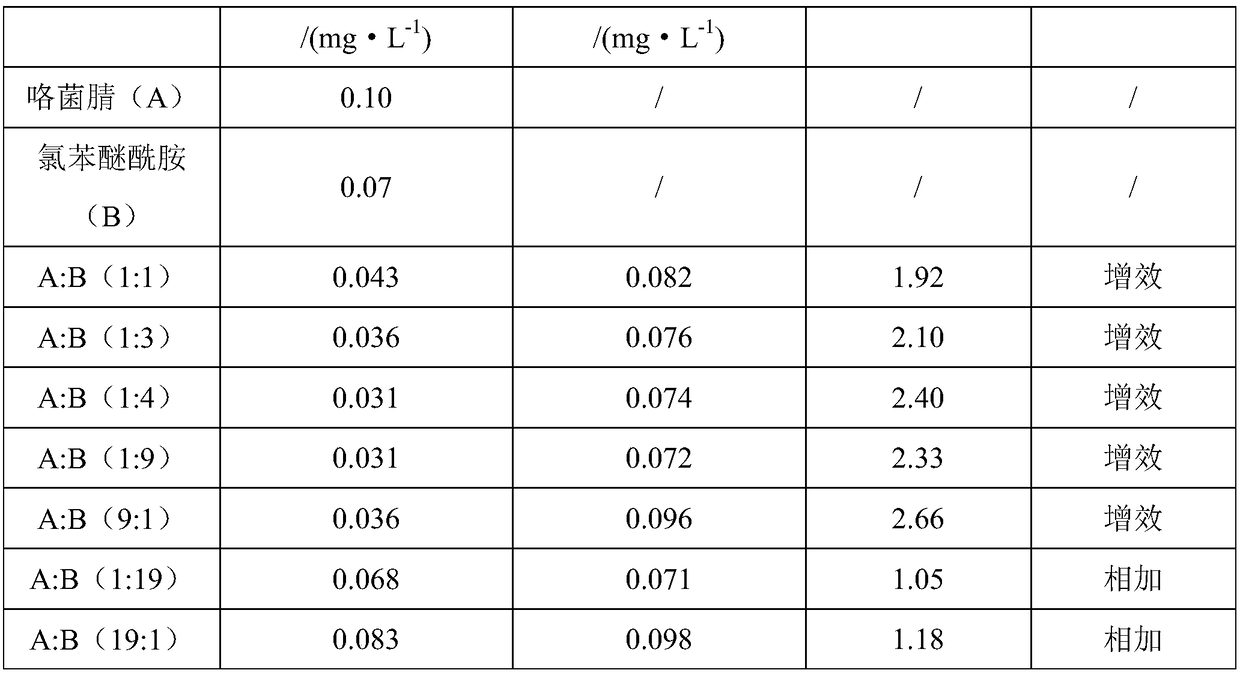Combined fungicide containing fludioxonil and N-(2-(2,4-dichlorophenoxy)phenyl)-3-(difluoromethyl)-1-methyl-1H-pyrazole-4-carboxamide
A technology of chlorophenyl ether amide and fludioxonil, which is applied in the directions of fungicides, biocides, biocides, etc., can solve the problems of increasing the dosage and frequency of medication, accelerating the formation of drug-resistant pathogen groups, and the failure of chemical control of drugs. , to achieve the effect of simple method of use, less resistance to drugs, and wider application spectrum of disease prevention
- Summary
- Abstract
- Description
- Claims
- Application Information
AI Technical Summary
Problems solved by technology
Method used
Image
Examples
Embodiment 1
[0029] Embodiment 1, indoor formula screening:
[0030] The determination of toxicity and synergistic coefficient is to dissolve the former drug of fludioxonil and the former drug of chlorophenyl ether amide respectively, configure the mother liquors of different ratios, and adopt the mycelia growth method to measure the inhibitory effect on Rhizoctonia solani (Table 1), Then calculate the EC 50 value and synergy factor. Results When the ratio of (A) fludioxonil from 1 to 9 and (B) chlorophenyl ether amide from 9 to 1 were compounded, they all showed obvious synergistic effect, and the SR coefficients were between 1.92 and 2.66. And when A:B is 1:19 or 19:1, both are additive, and SR are 1.05 and 1.18 respectively.
[0031] According to the main prevention and control objects, select the ratio of synergistic coefficient (SR) ≥ 1.5, and carry out appropriate dosage form processing.
[0032] Table 1. Formula screening for inhibiting Rhizoctonia solani
[0033]
[0034] ...
Embodiment 2
[0036] Embodiment 2, indoor formula screening:
[0037] The determination of toxicity and synergistic coefficient is to dissolve the former drug of fludioxonil and the former drug of chlorophenyl ether amide respectively, configure the mother liquors of different ratios, adopt the mycelia growth method to measure the inhibitory effect on botrytis cinerea (table 2), and then Calculate EC 50 value and synergy factor. Results When the ratio of (A) fludioxonil from 1 to 9 and (B) chlorophenyl ether amide from 9 to 1 were compounded, they all showed obvious synergistic effect, and the SR coefficients were between 2.05 and 2.68. And when A:B is 1:19 or 19:1, both are additive, and SR are 1.03 and 1.14 respectively.
[0038] According to the main prevention and control objects, select the ratio of synergistic coefficient (SR) ≥ 1.5, and carry out appropriate dosage form processing.
[0039] Table 2, the formula screening of inhibiting Botrytis cinerea
[0040]
[0041]
Embodiment 3
[0042] Embodiment 3, the formula screening of controlling boscalid resistant strawberry botrytis cinerea
[0043] The determination of toxicity and synergistic coefficient is to dissolve the former drug of fludioxonil and the former drug of chlorphenamide respectively, and configure them into different proportions of mother liquors, and adopt the mycelial growth method to measure the boscalid-resistant Botrytis cinerea (table 3 ) inhibition, and then calculate the EC 50 value and synergy factor. Results When the ratio of (A) fludioxonil from 1 to 9 and (B) chlorophenyl ether amide from 9 to 1 were compounded, they all showed obvious synergistic effect, and the SR coefficients were between 2.21 and 3.32. In the comparative test, the combination of (A) fludioxonil and (C) boscalid or (B) chlorphenamide and (C) boscalid, 1:1, 1:3 and No obvious synergistic effect was observed for 1:9, and the SR coefficients were between 0.91-0.99 and 1.04-1.44, respectively.
[0044] Table 3....
PUM
 Login to View More
Login to View More Abstract
Description
Claims
Application Information
 Login to View More
Login to View More - R&D
- Intellectual Property
- Life Sciences
- Materials
- Tech Scout
- Unparalleled Data Quality
- Higher Quality Content
- 60% Fewer Hallucinations
Browse by: Latest US Patents, China's latest patents, Technical Efficacy Thesaurus, Application Domain, Technology Topic, Popular Technical Reports.
© 2025 PatSnap. All rights reserved.Legal|Privacy policy|Modern Slavery Act Transparency Statement|Sitemap|About US| Contact US: help@patsnap.com



